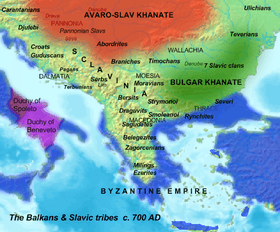Slavic invasion of the Balkans
The Slavic invasion of the Balkan Peninsula is considered to have taken place mostly in the first decades of the 7th century after a series of wars between the Sassanid Empire (Persia) and the Avar Khaganate against the Eastern Roman Empire. Also called the Byzantine Empire, it lost much of its territory in Egypt, the Levant, Asia Minor and the Balkans. Apart from the conflict for territory, these wars religious, with the Zoroastrians and Christians vying for power over Mesopotamia.[1] The backbone of the Avar Khaganate consisted of Slavic tribes, which, after the failed siege of Constantinople in the summer of 626, remained in the wider Balkans after they had settled the Byzantine provinces south of the river Sava and Danube, from the Adriatic toward Aegean up to the Black Sea.[2] Exhausted by wars and reduced to the coastal parts of the Balkans, Byzantium was not able to wage war on two fronts and to regain its lost territories, but it reconciled with the fact of establishing Slavic pagania and created an alliance with them against the Avar Khaganate in Pannonia.


The Byzantines directed their main army against Sassanid Persia in Asia Minor. Persia was defeated in Battle of Nineveh in 627 and never again became a serious opponent. However, in 630, Muhammad became the undisputed leader of the Arabs and triumphantly entered Mecca, which he had previously had to leave, and his faith, Islam, suddenly conquered larger and larger circles of Arab tribes.
After the destructive campaigns of Attila the Hun, Emperor Justinian I began the reconstruction of fortresses, cities and Christianity. However, after the settlement of the Slavs, the Balkans turned to paganism and entered the Dark Ages, in which most of Europe had been until then. In order to expand their cultural and state influence on the South Slavs, the Byzantines began the process of Christianization.[3]
The Slavic settlement in the Balkans had lasted for almost two centuries: from about 519 to the 8th century.[4] The settlement was facilitated by the substantial fall of the Balkan population during the Justinian plague.
The Slavs who settled in the Balkans are divided into two groups: Sclaveni and Antae.[5] These Slavs densely populated the Balkans, including the Peloponnese with Ezeritai and Melingoi and some Aegean islands, but also Anatolia with the so-called Asia Minor Slavs.
See also
- South Slavs
- Sarmatians
- Bulgars
- Avar-Byzantine wars
- Byzantine–Sasanian War of 602–628
- Sasanian conquest of Jerusalem
References
- The role of religion in the foreign affairs of Sasanian Iran and Later Roman Empire (330-630AD) by Joan Zouberi (2017)
- Martin Hurbanič (2019). The Avar Siege of Constantinople in 626: History and Legend. Springer. ISBN 9783030166847.
- On the Baptism of the Serbs and Croats in the time of Basil I (867-886) by Tibor Živković (2013)
- Barbarians in the Balkans
- Historische Angaben über das Eindringen von Slaven in Griechenland.
Literature
- Živković, Tibor (2007). Јужни Словени под византијском влашћу (South Slavs under Byzantine rule 600-1025AD). Čigoja. p. 504. ISBN 978-86-7558-501-5.CS1 maint: ref=harv (link)
- Fine, John V. A., Jr. (1991) [1983]. The Early Medieval Balkans: A Critical Survey from the Sixth to the Late Twelfth Century. Ann Arbor, Michigan: University of Michigan Press. ISBN 0-472-08149-7.
- Curta Florin (2001). The Making of the Slavs: History and Archaeology of the Lower Danube Region, c.500–700. Cembridge University. ISBN 9781139428880.CS1 maint: ref=harv (link)
- Georgios Kardaras (2018). Byzantium and the Avars, 6th-9th Century AD: Political, Diplomatic and Cultural Relations. Brill. ISBN 9789004248380.CS1 maint: ref=harv (link)
- Walter Pohl (2018). The Avars: A Steppe Empire in Central Europe, 567–822. Cornell University Press. ISBN 9781501729409.CS1 maint: ref=harv (link)
- Michael H. Dodgeon, Samuel N. C. Lieu (1991). The Roman Eastern Frontier and the Persian Wars AD 363-628. Psychology Press. ISBN 9780415465304.CS1 maint: ref=harv (link)
- Vladimir B. Sotirović (2018). On the Origins of Proto-Croats and Proto-Serbs. Vilnius University.CS1 maint: ref=harv (link)
- Peter Crawford (2013). The War of the Three Gods: Romans, Persians and the Rise of Islam. Pen and Sword. ISBN 9781848846128.CS1 maint: ref=harv (link)